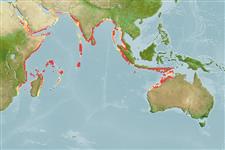klasifikasi / Names
Nama-nama umum | Sinonim (persamaan) | Catalog of Fishes(Marga, Jenis) | ITIS | CoL | WoRMS | Cloffa
>
Eupercaria/misc (Various families in series Eupercaria) >
Lutjanidae (Snappers) > Lutjaninae
Etymology: Lutjanus: Malay, ikan lutjan, name of a fish; indicus: Named for its Indian Ocean distribution..
Environment: milieu / climate zone / depth range / distribution range
Ekologi
laut; air tawar; payau berasosiasi dengan karang; kisaran kedalaman 5 - 50 m (Ref. 93093), usually 5 - 15 m (Ref. 93093). Tropical
Indian Ocean: northern continental margin of the Indian Ocean including western Thailand, Myanmar, Andaman Islands, Sri Lanka, India, Gulf of Oman and Arabian Gulf. Western Indian Ocean distribution of L. russellii mentioned in Allen & Talbot, 1985 (Ref. 469) is provisionally referred to as L. indicus; population needs to be reassessed..
Size / Weight / umur
Maturity: Lm ? range ? - ? cm
Max length : 22.6 cm SL jantan/; (Ref. 93093)
deskripsi pendek
Morfologi | Morfometrik
Duri punggung (Keseluruhan (total)): 10; duri punggung lunak (Keseluruhan (total)): 13-14; Duri dubur 3; Sirip dubur lunak: 8. This species is distinguished by the following set of characters: D X,13-14 (usually 14); total gill rakers 12-14; body depth 2.5-2.9 in SL; eye 4.2-4.6 in HL; interorbital 5.9-7.0 in HL; the scale rows above the lateral line rise obliquely toward dorsal profile; predorsal scales extending forward nearly to level of rear part of orbit; weakly developed preopercular notch and interopercular knob; upper surface of tongue with central patch of fine granular teeth; vomer with diamond-shaped to narrowly crescent-shaped patch of granular teeth with medial posterior extension; truncate caudal fin; in life it is overall pale grey, grading to silvery white on cheek, opercle, and lower side of body with series of seven dark brown to yellow stripes on posterior head and side, prominent black spot, about 1.2-1.5 size of eye, on posterior back below base of first 6-7 soft dorsal rays, its lowermost part occupying about one scale row below lateral line (Ref. 93093).
This species was observed in coral-reef habitat; generally encountered solitary or in small groups in about 5-15 m depth. It is also taken by trawlers in deeper water (to at least 50 m) and usually appears in fish markets. Few information on juvenile habitat, but suspected to be similar to L. russellii where young are found in brackish mangrove estuaries and lower reaches of freshwater streams (Ref. 93093).
Life cycle and mating behavior
Kematangan | Reproduksi, perkembang biakan | Pemijahan | telur-telur | Fecundity | Larva
Allen, G.R., W.T. White and M.V. Erdmann, 2013. Two new species of snappers (Pisces: Lutjanidae: Lutjanus) from the Indo-West Pacific. J. Ocean Sci. Found. 6:33-51. (Ref. 93093)
Status IUCN Red List (Ref. 130435)
ancaman kepada manusia
Harmless
penggunaan manusia
informasi lanjut
Nama-nama umumSinonim (persamaan)metabolismePemangsaEkotoksikologiReproduksi, perkembang biakanKematanganPemijahanSpawning aggregationFecunditytelur-telurpekembangan telor
Umur / SaizPertumbuhanpanjang-beratpanjang-panjangukuran frekuensiMorfometrikMorfologiLarvaDinamika larvapemulihanKelimpahanBRUVS
AcuanBudidaya airprofil budidaya airStrainGenetikaElectrophoresesDiturunkanPenyakit-penyakitPengolahanNutrientsMass conversion
mitraGambarStamps, Coins Misc.Suara-suaraCiguateraKecepatanTipe renangArea insangOtolithsOtakPenglihatan / visi
Alat, peralatan
laporan khas
muat turun XML
Sumber internet
Estimates based on models
Preferred temperature (Ref.
123201): 26.8 - 29.3, mean 28.3 °C (based on 684 cells).
Phylogenetic diversity index (Ref.
82804): PD
50 = 0.5000 [Uniqueness, from 0.5 = low to 2.0 = high].
Bayesian length-weight: a=0.01230 (0.00706 - 0.02143), b=2.94 (2.80 - 3.08), in cm total length, based on LWR estimates for this species & Genus-body shape (Ref.
93245).
Trophic level (Ref.
69278): 3.8 ±0.6 se; based on size and trophs of closest relatives
Daya lenting (Ref.
120179): Tinggi, Waktu penggandaan populasi minimum kurang dari 15 bulan (Preliminary K or Fecundity.).
Fishing Vulnerability (Ref.
59153): Low vulnerability (18 of 100).
